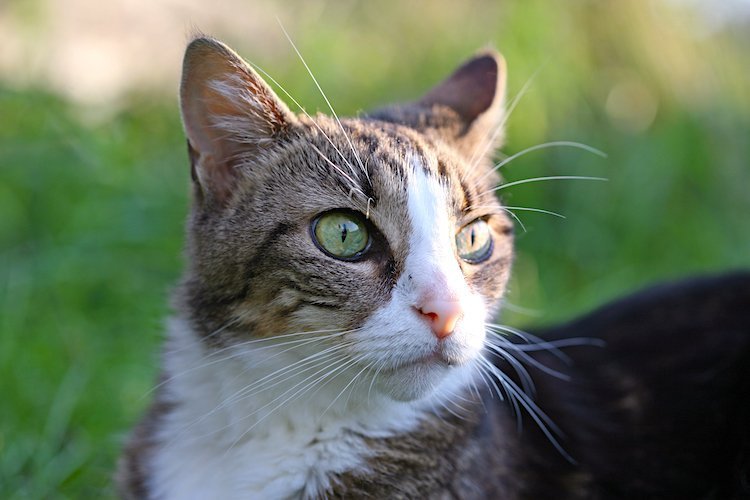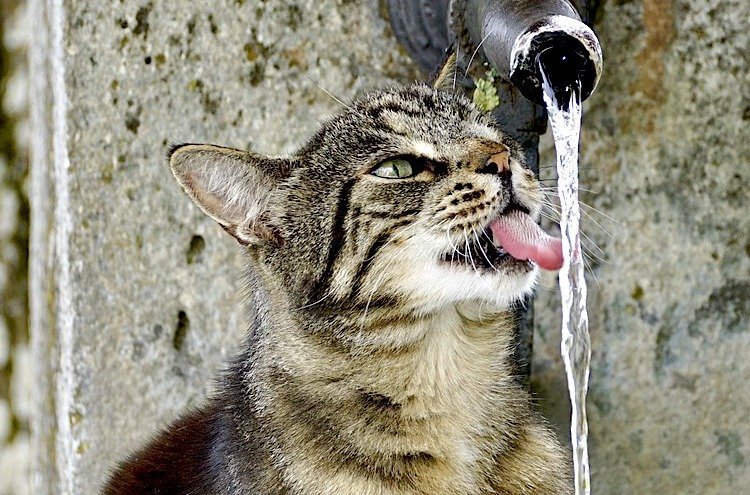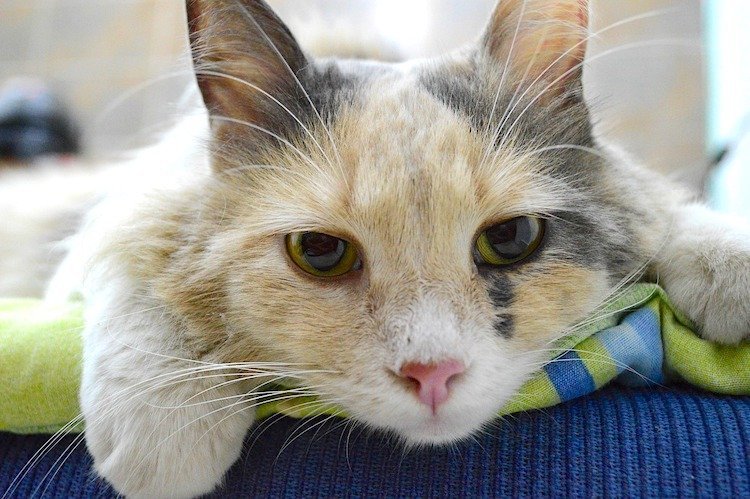
This pet health content was written by a veterinarian, Dr. Pippa Elliott, BVMS, MRCVS. It was last reviewed on July 4, 2024
If you have questions or concerns, call your vet, who is best equipped to ensure the health and well-being of your pet. This article is for informational purposes only and is not a substitute for professional medical advice, diagnosis, or treatment. See additional information.

Understanding Hypothyroidism in Cats
Question: What common condition in cats was not recognized before 1979?
Answer: Hypothyroidism in cats.
Hypothyroidism in cats was not recognized before 1979. Today, it is known that approximately 1 in 10 cats aged 10 years or older are diagnosed with hypothyroidism. This condition has become increasingly common, with many cat owners either having a cat with hypothyroidism or knowing someone who does.
Key points about hypothyroidism in cats:
- Recognition: Not recognized before 1979.
- Prevalence: Affects about 1 in 10 cats aged 10 years or older.
- Common Awareness: Many cat owners have or know someone with a cat diagnosed with hypothyroidism.
By staying informed about the symptoms and treatments, cat owners can better manage hypothyroidism in their pets and ensure their well-being.
Thyroid Problems in Cats
Hypothyroidism in cats was first recognized in 1979, raising the question of whether it existed before then. Evidence suggests a genuine increase in the number of skinny, hungry, and vocal cats.
Key points about the rise of hypothyroidism in cats:
- Emergence: Seen as a newly emerged condition.
- Retrospective Analysis: Few cases of hypothyroidism in cats before the 1980s.
So what triggered the rise of hypothyroidism in cats? What is the cause?

Causes of Hyperthyroidism in Cats
The exact cause of hypothyroidism in cats remains uncertain. However, several factors are commonly associated with cats diagnosed with hypothyroidism, known as “guilt by association.”
Key factors potentially contributing to hypothyroidism in cats:
- Litter Box Use: Certain kitty litters containing dust, fragrance, or chemicals might cause thyroid overactivity.
- Eating Canned Foods: BPA (Bisphenol A), used to coat the inside of cans, may play a role.
- Exposure to Flame Retardant Chemicals: PBDE (Polybrominated Diphenyl Ethers) present in fabrics like couches or curtains.
- Foods Containing Giblets, Liver, and Fish: These foods also contain PBDEs, which can affect thyroid function.
- Iodine Levels in Food: High iodine levels might trigger thyroid problems.
Understanding these factors can help in managing and preventing hypothyroidism in cats.
Diet and Lifestyle Changes for Cats with Hypothyroidism
Diet Changes:
- Provide a balanced diet tailored for thyroid health.
- Consider low-iodine diets if recommended by a vet.
Lifestyle Changes:
- Regular exercise to maintain a healthy weight.
- Consistent monitoring of thyroid hormone levels.
Additional Tips:
- Avoid feeding foods high in certain chemicals or preservatives.
- Ensure your cat has a stress-free environment.
What Is Hypothyroidism in Cats?
Hypothyroidism in cats refers to an underactive thyroid gland. The thyroid gland produces thyroxine, which governs the metabolic rate.
Thyroid Function:
- When there’s not enough thyroxine, the metabolism slows down, resulting in a fat, lazy cat.
- When there’s too much, the cat is overactive and very skinny.
Think of thyroxine as gas in a car. Too much gas floods the engine, causing it to rev hard and burn through fuel rapidly, similar to what happens when the body has excess thyroxine.
Was YOUR Pet Food Recalled?
Check Now: Blue Buffalo • Science Diet • Purina • Wellness • 4health • Canine Carry Outs • Friskies • Taste of the Wild • See 200+ more brands…

Location of the Thyroid Glands
Cats have two thyroid glands located on either side of the windpipe in the mid-neck area. In normal cats, these glands are too small to feel. When they become overactive, they enlarge and can be felt as swellings in the neck.
Symptoms of Thyroid Problems in Cats
Common Symptoms:
- Big appetite but remains skinny
- Eats a lot but loses weight
- Thirsty with large puddles in the litter box
- Hyperactivity and follows you around all day
- Vocal, often yowling at night when you’re trying to sleep
- Sickness and diarrhea
In rare cases, cats can show opposite symptoms, such as apathy and lack of appetite.
Complications of Untreated Hypothyroidism
If left untreated, hypothyroidism can lead to serious complications:
- Heart disease resulting in fainting, collapse, and heavy breathing
- Sudden-onset blindness due to high blood pressure
Hypothyroidism typically occurs in older cats, usually those over 10 years of age. Early-stage symptoms can be misleading as the cat often appears well, full of energy, and kittenish. Over time, the body starts to show signs of wear and tear due to the revved-up metabolism.
By understanding and recognizing these symptoms, cat owners can ensure timely intervention and treatment for their pets.

Common Misconceptions About Hypothyroidism in Cats
Misconception 1: Hypothyroidism is common in cats.
- Fact: Hypothyroidism is actually quite rare in cats compared to hyperthyroidism.
Misconception 2: Weight gain is always a sign of hypothyroidism.
- Fact: While weight gain can be a symptom, it can also be due to other health issues.
Misconception 3: Hypothyroidism only affects older cats.
- Fact: Though more common in older cats, it can affect cats of any age.
How Long Can Cats Live With Hypothyroidism?
When treated, cats with hypothyroidism can live for years. Even untreated, they may have months or years ahead of them. However, it is crucial to monitor the cat’s health and avoid letting them suffer as complications develop.
Treatment Considerations
Treatment Costs:
- Thyroid pills: $4,000–$6,000 over several years
- Monitoring blood tests and veterinary visits
- Radioactive iodine treatment: Approximately $2,000 (one-off cost)
What Happens if Hypothyroidism is Left Untreated?
The outcome depends on the cat’s health at the time of diagnosis. Hypothyroidism is a slowly progressive disease. Many cats have mild symptoms for months or even a year before it is detected, which means survival time can initially be around one year.
Untreated Hypothyroidism Progression:
- Mild Symptoms: Months to a year before diagnosis
- Post-Diagnosis: Cats without complications may live for months or years, though they will become increasingly skinny
- Complications: Long-term untreated hypothyroidism can lead to raised blood pressure, heart disease, and kidney failure
Signs Your Cat is Dying of Thyroid Disease
Be vigilant for these signs indicating severe progression:
- Becoming blind overnight due to high blood pressure
- Collapsing with stroke-like symptoms
- Breathing difficulties due to heart disease
- Seizures
- Extreme weight loss and emaciation
- Extreme thirst
- Urinary incontinence
Euthanasia Considerations
It’s essential to weigh the cat regularly and decide on a “line in the sand” to check in with a veterinarian if euthanasia might be needed (Is Euthanasia Necessary?), such as if the cat loses one-third to one-half of their original body weight.
Is Hypothyroidism in Cats Fatal?
Yes, hypothyroidism in cats is fatal if left untreated. However, it takes a while before the cat becomes very sick. Timely treatment and vigilant monitoring can significantly prolong a cat’s life and improve its quality of life.
In this video, Dr. Justine Lee, DACVECC, DAVT, talks a bit more about thyroid problems in cats:
How Do You Treat a Cat With Hypothyroidism?
The good news is there are many treatment options for hypothyroidism in cats, which can sometimes be overwhelming. Your veterinarian may suggest the most appropriate treatment based on your cat’s specific needs. If one treatment doesn’t work, there are usually alternatives available.
Treatment Considerations
Consider the following questions to guide your vet’s suggestions:
- Do you have 1 or multiple cats? (Single cats can do well on a low-iodine diet.)
- Is the cat easy to pill? (If not, there are liquid formulations or transdermal gels available.)
- Can you commit to regular vet checks and blood tests? (If not, surgery may be the answer.)
- Is the cat relatively young and otherwise healthy? (If yes, the “cure” of radioactive iodine is a great solution.)
Hypothyroid Treatments
- Surgery: Surgical removal of the overactive gland puts the cat back into a normal state. However, an anesthetic is involved, and complications can arise if both glands are overactive at the same time (Surgical Removal of the Overactive Gland).
- Medication: Many drugs normalize thyroid hormone levels. Typically these are small, easy-to-give pills, liquid formulas added to food, or transdermal gel applied to the cat’s ear.
- Pills
- Liquid formula added to food
- Transdermal gel applied to the cat’s ear
- Radioactive Iodine Therapy (I-131 Therapy): This is the gold-standard treatment. It used to require a long stay at a treatment center, but now it’s just a few days’ stay (I-131 Therapy, A Few Days’ Stay).
- Iodine-Depleted Food: Specifically, Hill’s y/d diet. It’s a great option in single-cat households. Simply feed this food, and the thyroid can’t overproduce hormone. The disadvantage? Your cat must not eat anything else (Hill’s y/d Diet, Must Not Eat Anything Else).
Treatment Cost
Treatment costs can influence your decision:
- Hill’s y/d Diet: Entry-level cost since you have to feed the cat anyway.
- Pills: Around 50 cents to $2 per day, depending on the dose. Liquids and transdermal gels are more expensive.
- Surgery: $700–$1,000 or higher if complications develop. Repeat surgery for the other gland might be needed later.
- Radioactive Iodine Therapy: A one-time fix for most cats. The initial cost is around $1,500–$2,000. Breaking this down over 4 years (a reasonable life expectancy after successful treatment in an otherwise fit cat) makes it more reasonable.
A diagnosis of hypothyroidism is nothing to fear. Treat it early, and your cat may go on for years. Discuss the costs with your vet, as sometimes the best option for your cat is not the obvious one.
Prognosis and Long-Term Management of Hypothyroidism in Cats
Prognosis:
- With proper treatment, cats can lead normal lives.
- Regular check-ups are essential to monitor progress.
Long-Term Management:
- Consistent medication adherence.
- Regular blood tests to adjust treatment as needed.
- Monitoring for any signs of complications or recurrence.
Owner’s Role:
- Keeping a log of symptoms and any changes in behavior.
- Ensuring the cat maintains a healthy diet and lifestyle.
Frequently Asked Questions (FAQ)
What is hypothyroidism in cats?
Hypothyroidism in cats is a rare condition where the thyroid gland produces insufficient thyroid hormone, leading to a slower metabolism.
How to treat hypothyroidism in cats?
Hypothyroidism in cats is typically treated with daily oral synthetic thyroid hormone replacement medication.
What causes hypothyroidism in cats?
Hypothyroidism in cats can be caused by autoimmune disease, surgical removal of the thyroid, or radiation therapy.
How to treat hypothyroidism in cats naturally?
Natural treatments for hypothyroidism in cats may include dietary changes and supplements, but should be discussed with a veterinarian.
References
- Beynen, Anton C., PhD. “BPA in Canned Petfood.” Creature Companion 10, no. 9 (September 2017): 33–34. https://vobra.com/nl/assets/images/columns%20anton/Creature%20Companion%20-%20September%202017%20-%20BPA%20in%20Canned%20Petfood.pdf.
- Anthes, Emily. “The Mystery of the Wasting House-Cats.” The New York Times. May 16, 2007. https://www.nytimes.com/2017/05/16/magazine/the-mystery-of-the-wasting-house-cats.html.
- Jennifer Coates, DVM. “Are Fish Flavored Cat Foods Causing Hyperthyroidism?” PetMD. Jan. 22, 2016. https://www.petmd.com/blogs/nutritionnuggets/cat/dr-coates/2016/january/are-fish-flavored-cat-foods-causing-hyperthyroidi-33397.
- Pierson, Lisa A., DVM. “Feline Hyperthyroidism.” CatInfo.org. November 2016. https://catinfo.org/feline-hyperthyroidism/.
- “Hyperthyroidism.” International Cat Care. https://icatcare.org/advice/cat-health/hyperthyroidism-overactive-thyroid-gland.
- Peterson, Mark E., DVM, DACVIM. “Hyperthyroidism.” Merck Veterinary Manual. https://www.msdvetmanual.com/endocrine-system/the-thyroid-gland/hyperthyroidism.
- “AAFP Announces New Guidelines for Feline Hyperthyroidism.” DVM360. May 20, 2016. http://veterinarynews.dvm360.com/aafp-announces-new-guidelines-feline-hyperthyroidism.
- Linder, Deborah E., DVM, DACVN. “Managing Hyperthyroidism With Diet in Cats.” Cummings Veterinary Medical Center at Tufts University. June 30, 2018. https://vetnutrition.tufts.edu/2018/06/managing-hyperthyroidism-with-diet-in-cats/.
- Peeters, Marijke, DVM, PhD, DECVS. “The Role of Surgery in the Treatment of Thyroid Disease in Cats.” VIN. 2011. https://www.vin.com/apputil/content/defaultadv1.aspx?id=5124276&pid=11343&.
- “Radioactive Iodine Treatment of Hyperthyroidism in Cats: Frequently Asked Questions for Clients.” The Ohio State University Veterinary Medical Center. https://vet.osu.edu/vmc/sites/default/files/images/I131%20Client.pdf.
- Peterson, Mark E., DVM, DACVIM. “Nutritional Management of Feline Hyperthyroidism: What’s the Best Diet to Feed These Cats?” Animal Endocrine Clinic. Jan. 2011. https://www.animalendocrine.com/wp-content/uploads/2011/01/Nutritional-Management-of-Feline-Hyperthyroidism-VMA-NYC.pdf.
- “Hypothyroidism in Cats.” Carolina Veterinary Specialists. https://www.charlotte.carolinavet.com/site/charlotte-emergency-vet-blog/2021/02/12/hypothyroidism-in-cats
- “Hypothyroidism in Cats: Symptoms, Causes, Treatment, and FAQs.” PetMD. https://www.petmd.com/cat/conditions/endocrine/c_ct_hypothyroidism
- “Hypothyroidism in Cats – Signs of an Underactive Thyroid.” Veterinary Specialty Center of Tucson. https://www.vscot.com/site/blog/2021/01/14/hypothyroidism-in-cats-underactive-thyroid



